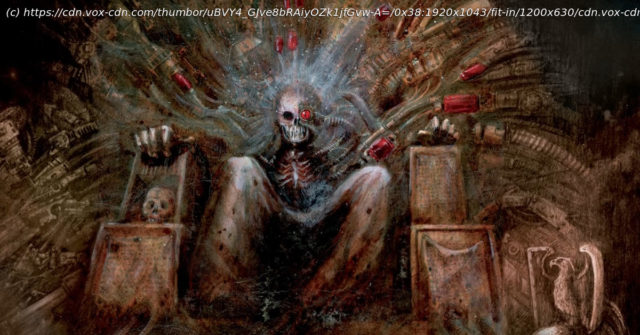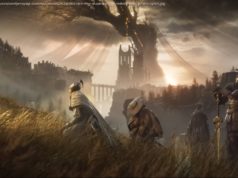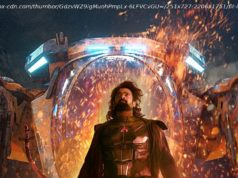Warhammer 40,000 has expanded far past the original wargame to become a massive franchise with decades of lore to parse through. Here’s what you need to know.
Warhammer 40,000 is a tabletop wargame played with miniatures that first launched in the 1980s, alongside rulebooks packed with additional fluff and lore. Decades later, that fluff has sprawled out into its own massive narrative universe, and the lore has been adapted into novels, audio dramas, movies, animation, and video games. Warhammer 40K, the media property, is currently in pre-production as a TV and cinematic universe led by Superman and The Witcher star Henry Cavill. Meanwhile, the wargame is about to enter its 10th edition, which aims to be more accessible and pared-down than previous versions.
You’ve likely seen images from the brand, or announcements about a new game or adaptation in the universe. If you’re curious about this huge franchise, you probably want to know: What is the world of Warhammer 40K about? Let’s dive in.What even is a Warhammer 40K?
There has been little active curation of Warhammer 40K canon. Instead, Games Workshop and its publishing arm Black Library has taken the stance that everything ever written about its sprawling lore is “true” — all of it is canon, more or less since its inception in the 1980s. Just like actual history, no single narrator or historian in the grim darkness of the far future is 100% reliable. Instead, it’s up to the reader to sift through all the dusty — and highly collectible — tomes in order to parse its primary sources.
Much like real history, it can be hard to piece everything together. Fan wikis and forums can be esoteric and packed with proper nouns. Meanwhile, since the narrative has never been rebooted or retconned, there are few official on-ramps for new players. But it’s possible to engage with the 40K fandom with a running start, gathering up bits of its nearly 40-year backstory as you go along. We’ve created this guide with newcomers in mind, and we’ll pepper our primer with recommendations for games, books, videos, and even entire factions that you might want to learn more about.Warhammer 40k’s setting
Warhammer 40K began as a pastiche of science fiction and fantasy tropes. For instance, looking back at its inception in the late ’80s, you’ll find elements from Frank Herbert’s Dune, with a God-Emperor, a hatred of AI, and the spacefaring Navigators. But, even early on, you’ll also find more literary call-backs, including nods to John Milton’s Paradise Lost.
Its earliest official work, Warhammer 40,000: Rogue Trader (written by Rick Priestly), begins with a preamble, a kind of Star Wars-style opening crawl that lays out the most basic facts that the reader needs to know. It’s been changed and altered over the years, but here are the original words from 1987:
Later rewrites of this piece add in references to the top-selling Space Marines and their comrades, but the bleakness of the God Emperor’s reign has never been in question.
Warhammer 40K was originally conceived as a political satire and as an anti-fascist work of fiction. Nevertheless, over the decades, the hobby has attracted no small number of right-wing fans who buy into either the in-universe propaganda of the Imperium, or the marketing materials that describe the Space Marines and friends as noble protectors of humanity. In recent years, Games Workshop has spoken out against this fan movement, itself calling back to the original preamble penned by Priestly.Meet the Imperium of Man
Before we delve into the finer details of the modern setting, it’s clear that humanity should not be thought of as the good guys in 40K. From the very beginning of the franchise to the current day, the Imperium is one of the most villainous factions in the entire galaxy, as cruel or perhaps more cruel to its own citizens than it is to outsiders it considers to be a threat to its way of life.
The Imperium remain the franchise’s nominal main characters. They give the larger fiction its point-of-view in most instances, and absorb much of the spotlight. This is even more extreme with the Space Marines, Games Workshop’s top sellers. Authors will often hype them up and praise their virtues, outright ignoring or otherwise skipping over uncomfortable topics like their tendency toward fascism and their origins as brainwashed child soldiers.
So, why are they so dang fun to read about? Take Frank Herbert’s Dune, gothic Christian imagery ramped up to 11, and giant war machines. Throw them all in a blender, and you get 40K’s Imperium of Man. Battle nuns drop cathedral tanks from orbit on their enemies. The Adeptus Mechanicus, a transhuman faction of religious cyborgs, chant religious rites to the machine spirits inside tanks. The Astra Militarum, also known as the Imperial Guard, is a faction made up of trillions of normal dudes in flak armor whose commissars urge them forward at gunpoint. It’s a wild take on dystopian, far-future sci-fi, far removed from any of our current problems. The Imperium fucking sucks to live in, but it’s fun to read about, and they have one redeeming quality — they aren’t the other guys.Recommended Media:
Space Marine is a solid and accessible action game that stars Captain Titus, an Ultramarine at war against the Orks invading Forge World Graia.
Darktide is the best chance you’ll have to explore a Hive City for yourself. The level design and soundtrack are immaculate and make Warhammer 40K feel very tangible.
The Vaults of Terra series by Chris Wraight is a procedural crime drama that takes place on Terra, at the foot of the Golden Throne itself.
The Inquisition novels by Dan Abnett make up a sprawling trilogy of trilogies, packed full of day-to-day life for the poor souls in the Imperium — and the Inquisitors who watch over them.
Fire Caste by Peter Fehervari is an Apocalypse Now homage, told through the tale of Imperial Guard soldiers pursuing warriors of the T’au Empire.From 15K to 40K
The Imperium is based on real-world history, but since it’s so far in the future, there are some big gaps in the timeline. We know that the Emperor of Mankind and his closest group of allies are Perpetuals, immortal humans that are reborn into new vessels after perishing. They’ve been in the background of all of history, pulling strings and setting up pieces on the chess board. Here are some of humanity’s historical eras that end up setting the scene for 40K.
Dark Age of Technology (~15,000-25,000 CE): Long after we were all gone, humanity hit its pinnacle and created a fully automated space utopia. Then, the AI-controlled Men of Iron rose up to kill humanity — and almost succeeded. This is why AI has been outlawed in 40K; the acronym now stands for abominable intelligence. In its place is a kind of horrific bio-engineering, which uses human minds and bodies as the material for new robot-like entities like servo-skulls and servitors. The Dark Age tech that survived usually crops up again and again in the modern timeline to cause some kind of problem, but we otherwise know very little about this era.
Age of Strife/The Long Night: With space travel shut off and the Men of Iron revolt leaving humanity in ruins, the survivors fell to civil war, Mad Max: Fury Road style, but across multiple star systems. The Emperor of Mankind showed up on the main stage, created a faulty race of transhuman soldiers known as the Thunder Warriors, and forcibly united humanity under his banner.






